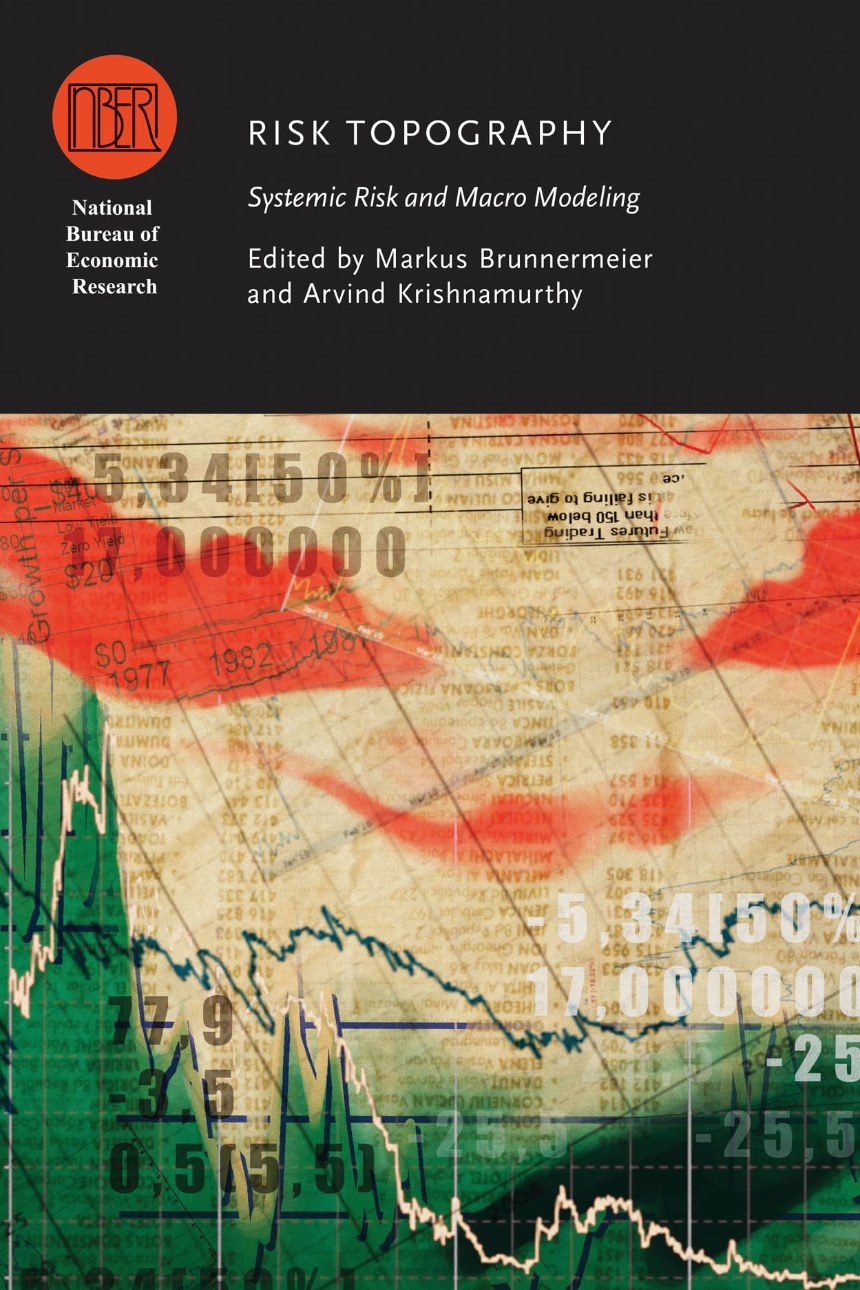Risk Topography
Systemic Risk and Macro Modeling
The recent financial crisis and the difficulty of using mainstream macroeconomic models to accurately monitor and assess systemic risk have stimulated new analyses of how we measure economic activity and the development of more sophisticated models in which the financial sector plays a greater role.
Markus Brunnermeier and Arvind Krishnamurthy have assembled contributions from leading academic researchers, central bankers, and other financial-market experts to explore the possibilities for advancing macroeconomic modeling in order to achieve more accurate economic measurement. Essays in this volume focus on the development of models capable of highlighting the vulnerabilities that leave the economy susceptible to adverse feedback loops and liquidity spirals. While these types of vulnerabilities have often been identified, they have not been consistently measured. In a financial world of increasing complexity and uncertainty, this volume is an invaluable resource for policymakers working to improve current measurement systems and for academics concerned with conceptualizing effective measurement.
Markus Brunnermeier and Arvind Krishnamurthy have assembled contributions from leading academic researchers, central bankers, and other financial-market experts to explore the possibilities for advancing macroeconomic modeling in order to achieve more accurate economic measurement. Essays in this volume focus on the development of models capable of highlighting the vulnerabilities that leave the economy susceptible to adverse feedback loops and liquidity spirals. While these types of vulnerabilities have often been identified, they have not been consistently measured. In a financial world of increasing complexity and uncertainty, this volume is an invaluable resource for policymakers working to improve current measurement systems and for academics concerned with conceptualizing effective measurement.
288 pages | 28 line drawings, 14 tables | 6 x 9 | © 2014
National Bureau of Economic Research Conference Report
Economics and Business: Economics--Econometrics and Statistics, Economics--General Theory and Principles
Reviews
Table of Contents
Acknowledgments
Introduction
Markus Brunnermeier and Arvind Krishnamurthy
I. Measurement and Disclosure
1. Challenges in Identifying and Measuring Systemic Risk
Lars Peter Hansen
2. Regulating Systemic Risk through Transparency: Trade-Offs in Making Data Public
Augustin Landier and David Thesmar
II. Risk Exposures
3. Systemic Risk Exposures: A 10-by-10-by-10 Approach
Darrell Duffie
4. Remapping the Flow of Funds
Juliane Begenau, Monika Piazzesi, and Martin Schneider
5. Measuring Margin
Robert L. McDonald
6. A Transparency Standard for Derivatives
Viral V. Acharya
III. Liquidity and Leverage
7. Liquidity Mismatch Measurement
Markus Brunnermeier, Arvind Krishnamurthy, and Gary Gorton
8. Monitoring Leverage
John Geanakoplos and Lasse Heje Pedersen
IV. Financial Intermediation and Credit
9. Repo and Securities Lending
Tobias Adrian, Brian Begalle, Adam Copeland, and Antoine Martin
10. Improving Our Ability to Monitor Bank Lending
William F. Bassett, Simon Gilchrist, Gretchen C. Weinbach, and Egon Zakrajšek
11. The Case for a Credit Registry
Atif Mian
V. Household Sector
12. Monitoring the Financial Condition and Expenditures of Households
Robert E. Hall
13. LEADS on Macroeconomic Risks to and from the Household Sector
Jonathan A. Parker
14. Detecting “Bad” Leverage
Amir Sufi
VI. Corporate Sector
15. A Macroeconomist’s Wish List of Financial Data
V. V. Chari
VII. International Sector
16. Systemic Risks in Global Banking: What Available Data Can Tell Us and What More Data Are Needed?
Eugenio Cerutti, Stijn Claessens, and Patrick McGuire
Contributors
Author Index
Subject Index
Introduction
Markus Brunnermeier and Arvind Krishnamurthy
I. Measurement and Disclosure
1. Challenges in Identifying and Measuring Systemic Risk
Lars Peter Hansen
2. Regulating Systemic Risk through Transparency: Trade-Offs in Making Data Public
Augustin Landier and David Thesmar
II. Risk Exposures
3. Systemic Risk Exposures: A 10-by-10-by-10 Approach
Darrell Duffie
4. Remapping the Flow of Funds
Juliane Begenau, Monika Piazzesi, and Martin Schneider
5. Measuring Margin
Robert L. McDonald
6. A Transparency Standard for Derivatives
Viral V. Acharya
III. Liquidity and Leverage
7. Liquidity Mismatch Measurement
Markus Brunnermeier, Arvind Krishnamurthy, and Gary Gorton
8. Monitoring Leverage
John Geanakoplos and Lasse Heje Pedersen
IV. Financial Intermediation and Credit
9. Repo and Securities Lending
Tobias Adrian, Brian Begalle, Adam Copeland, and Antoine Martin
10. Improving Our Ability to Monitor Bank Lending
William F. Bassett, Simon Gilchrist, Gretchen C. Weinbach, and Egon Zakrajšek
11. The Case for a Credit Registry
Atif Mian
V. Household Sector
12. Monitoring the Financial Condition and Expenditures of Households
Robert E. Hall
13. LEADS on Macroeconomic Risks to and from the Household Sector
Jonathan A. Parker
14. Detecting “Bad” Leverage
Amir Sufi
VI. Corporate Sector
15. A Macroeconomist’s Wish List of Financial Data
V. V. Chari
VII. International Sector
16. Systemic Risks in Global Banking: What Available Data Can Tell Us and What More Data Are Needed?
Eugenio Cerutti, Stijn Claessens, and Patrick McGuire
Contributors
Author Index
Subject Index
